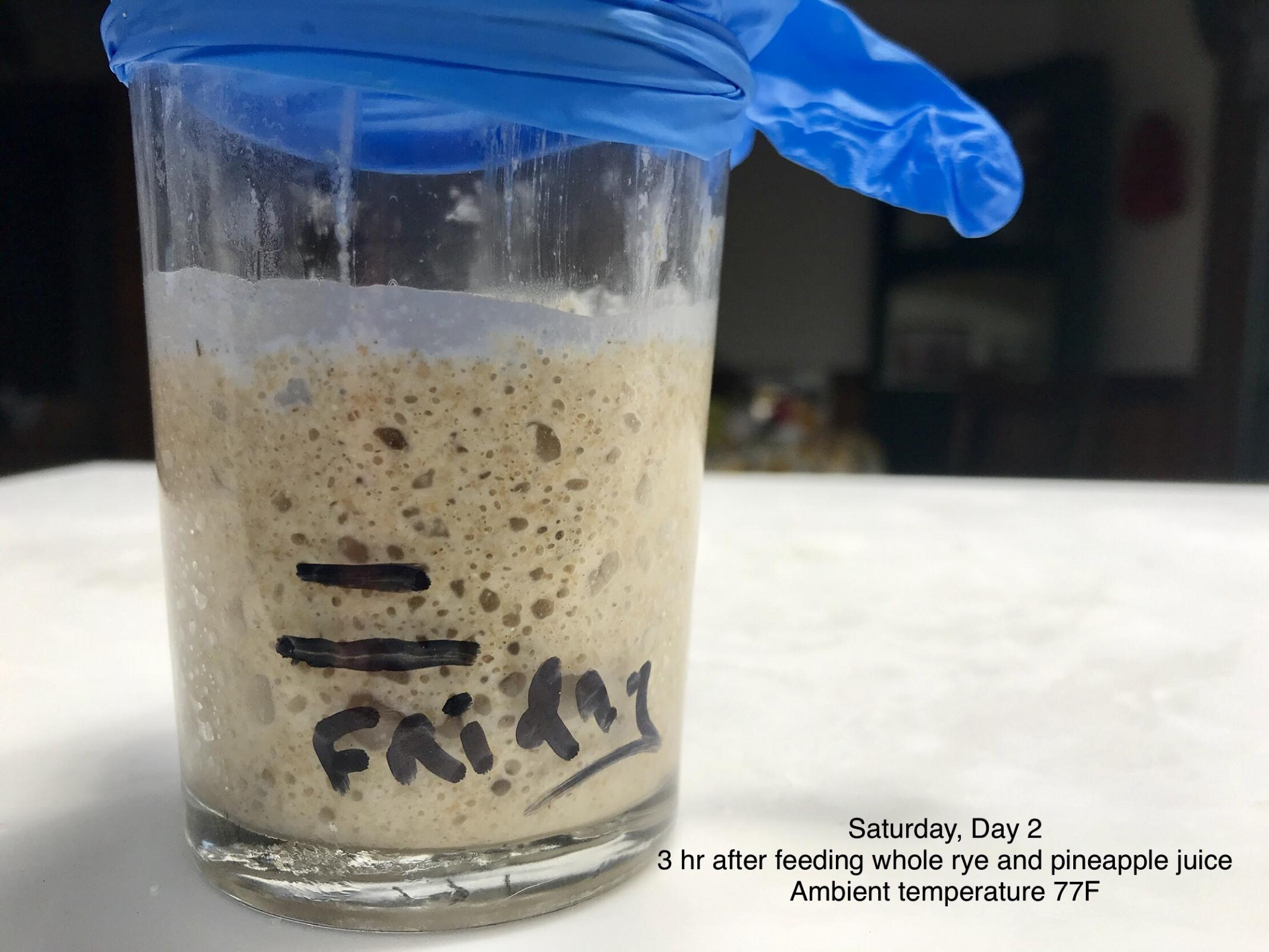
Looking for experienced input and observation.
I am in the process of starting a new starter from scratch according to Debra’s instructions.
http://www.thefreshloaf.com/node/10856/pineapple-juice-solution-part-1
http://www.thefreshloaf.com/node/10901/pineapple-juice-solution-part-2
The nitty gritty...
http://forums.finecooking.com/print/node/63318?page=2&comment=737624
The starter uses home milled organic rye and fresh squeezed pineapple juice. The image above shows tremendous growth 3 hours past the second (24hr) feed. I have never experienced the foul smelling bad bacteria (Leuconostoc species) phase that I read about. And I am fairly sure this is not the case with this starter. It seems fine.
The image was taken after only 27 hours of total fermentation (since inception) at an ambient temp of 77F. All liquids are pineapple juice. What is going on?
Danny
Update - Immediately after photographing the top image the stirred was stirred down (it feel to the top line). The image below was taken 1 1/2 hr later. Ambient temp is 77F. Starter smells fine.
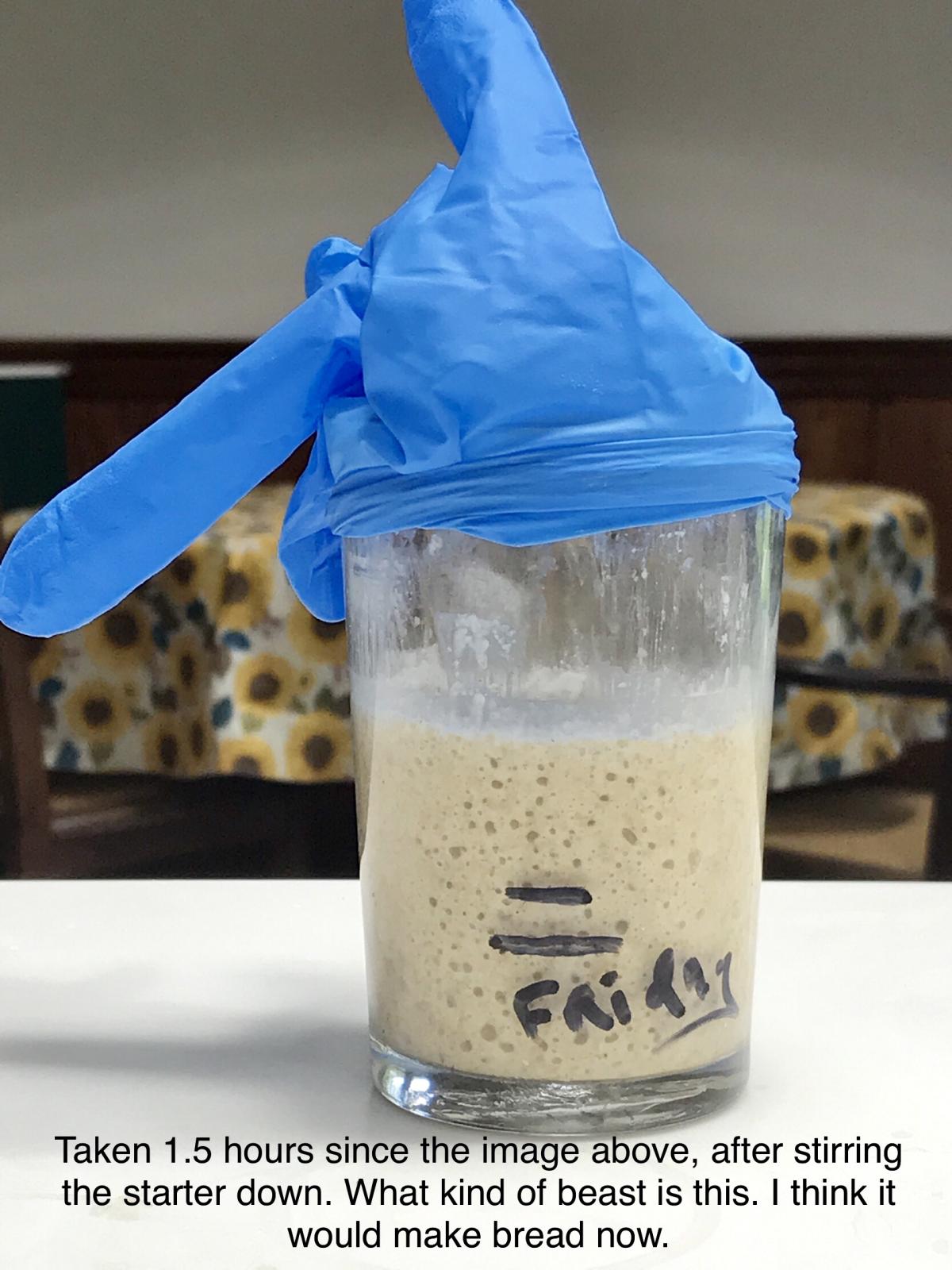
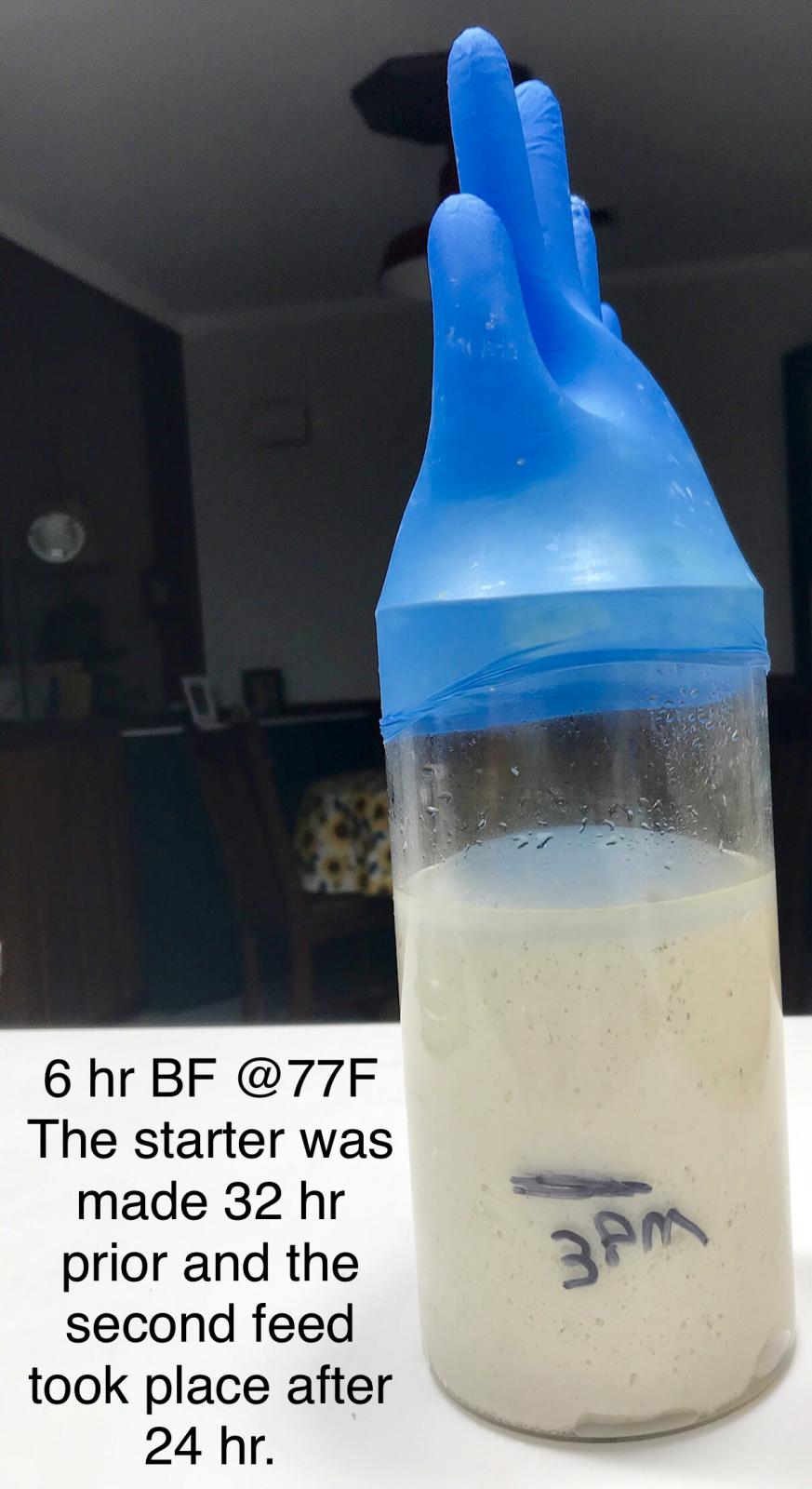
Not bad for a 30 hr old starter. It ain’t pretty and the taste leaves much to be desired, but it is bread...
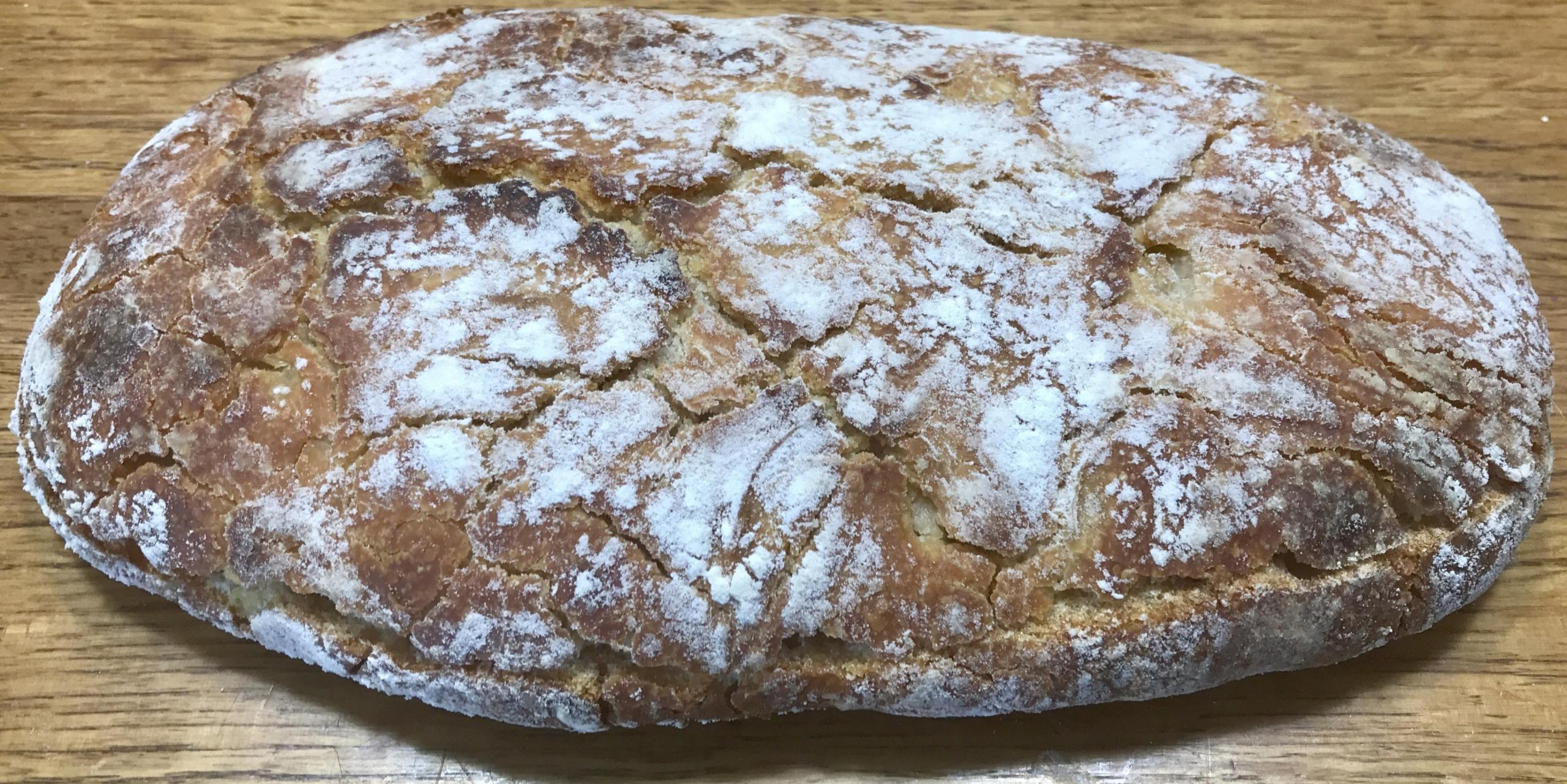
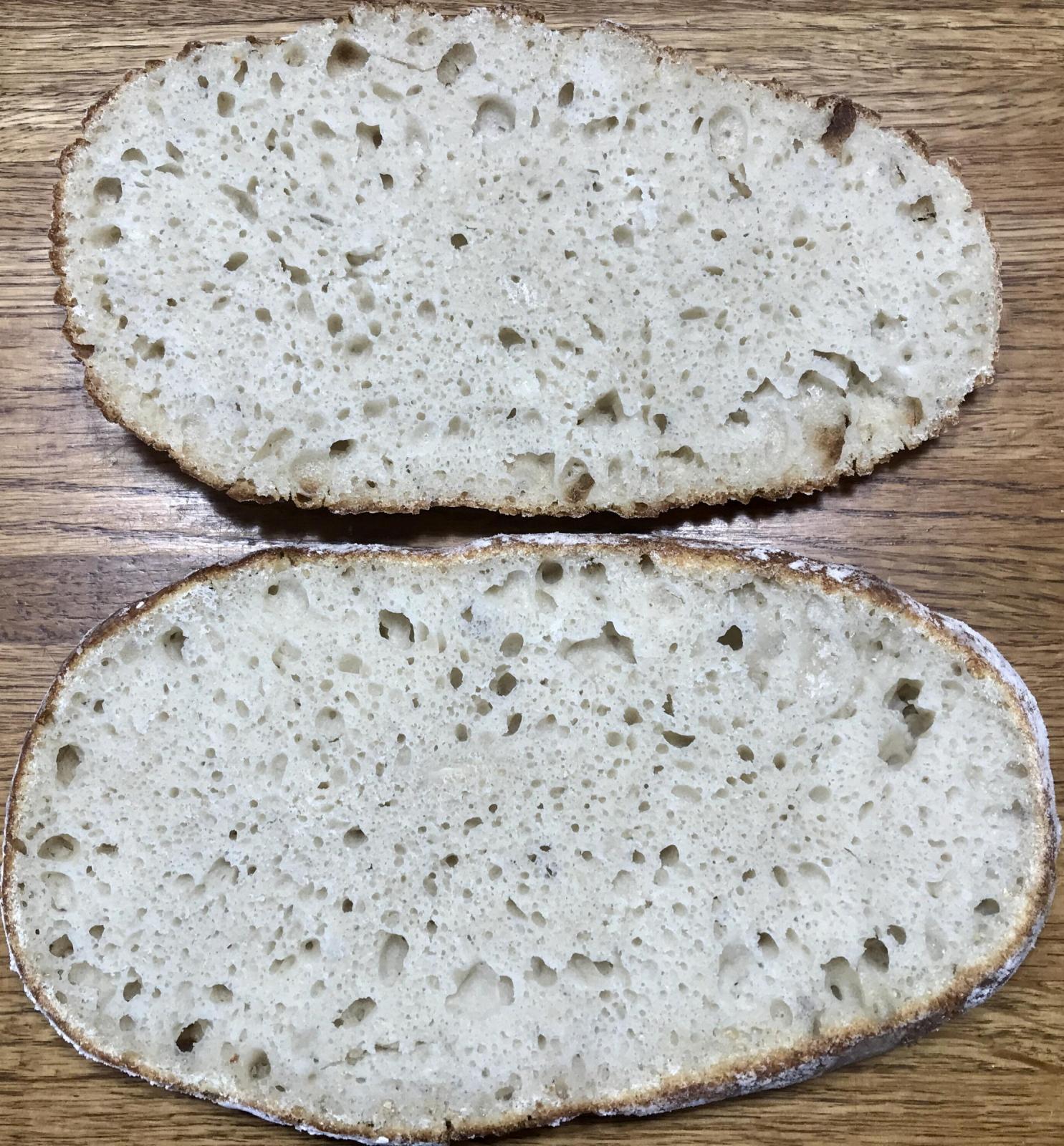
Wow that is something. In my blog posts I showed some of the development of my rye starter with pineapple juice. There was absolutely no comparison to the whole wheat pineapple juice starter. The rye starter smelled good at all stages and was showing activity from day 1.
Day 2 a few hours after feeding this is what my rye starter looked like.
Day 3 Several hours after feeding.
Yours being fresher rye that you just ground is amazingly more active so quickly. I thought mine was pretty good but yours is amazing Dan.
Ben, it has been a while since I started a starter. I am amazed at how fast both of our starters have grown so early in the process.
Danny
Thicken it up and see what it does?
Hey, how does one squeeze a pineapple?
Maybe pineapple is super ripe and already fermenting before combining with flour?
Mini, I tried a garlic press, but that didn’t work so well. I think the fibrous parts made drainage difficult. I ended up smashing with a fork and pouring over a strainer. Keep in mind, I only needed 2 tablespoons.
Maybe you hit it on the nail. Maybe I’m raising a combo YW/starter.
This starter is blowing my mind. I decided to try to bake a small bread after the starter was 30 hr old. Just to see.
I am also recording a time lapse video of the starter as I write this. Will post when complete.
I don’t know what to believe about this “thing”.
24 - 36 hours in. In fact I don't feed it at all until it shows activity. Mix and wait then only feed again when it bubbles up. They often more than triple (depending on flour and hydration). No need to feed until your starter has done this. Don't use pineapple juice just flour and plain water. Then once the starter begins to settle down I'll then begin to feed it. If fed too early it just bubbles up again within a few hours. All you're doing is feeding the quick off the mark yeasts/bacteria that are still very active. Not the ones found in a stable starter. Then a feed or two later it will begin to slow down or might even go to sleep in which case I'll feed only when it shows signs of activity or stop feeding altogether. From here on in its keep it warm, feed when it needs to be fed and how much depends on how strong it is. If it's kept warm enough and the feedings with the amounts are timed /calculated well then it should be viable within a week. If not then it can take up to two weeks. My understanding of the pineapple juice is just to give it that extra edge as a starter needs to become acidic to support the little critters in a starter and in the pineapple juice method you're doing by adding it in.
Abe, I am trying to follow Debra’s Pineapple Solution. The only deviation is I am using fresh pineapple instead of store bought juice. It is rising and falling in less than 4 hr. I am going to document this via video. I think Mini’s idea about introducing yeast from the pineapple may be valid. But then again, don’t the yeast only exist on the outside? I only used the inner portion.
Update - I went to the trouble to set up the time lapse video (lights and all) and the iPad ran out of power and died. <SAD>
Dan
According to Michael the quick off the mark bubbling up can come from yeasts as well but might not be the ones that eventually populate a viable sourdough starter. Perhaps the pineapple juice has made them super active but you still might experience the day 4 (or 5) quiet period. See what happens when you switch to water.
If you wish you can try another starter (if not too much trouble) with boiled water that has been cooled and whole rye flour. Mix together a 100% hydration starter of about 100g. Keep it warm and don't feed it again for a day or two. Until you see it bubbles up. You should see the same activity.
My rye pineapple juice starter had a major slowdown of activity on day 4 and then a huge increase on day 5 where it more than tripled in volume and passed the float test.
Do you remember feeding it when it slowed down or did you let it ferment longer, getting more acid?
On day 4 when it became somewhat sluggish and rose little, it was the last day that I fed it rye flour and the first day I gave it water. Day 5 I discarded 80% of the culture and fed it 1:2:2 white bread flour and water. 19 hours later it tripled in volume and 21 hours later it overflowed.
The starter is moving so fast I thought why not try a bake. So, after the initial feed, then the second feed (24 hr later), and finally 6 hr into the second feed, the dough was mixed. It was 30 hours since the starter was initially started. It was maintained @ 77F. The dough was mixed at 70% hydration, rested 30 min and then 150 slap and folds, then rested 30 more min. The first 150 slap and folds looked promising. I have never felt a dough that was so silky and smooth. BUT when I went to continue the second set of slap & folds things turned very bad. The dough looked like soft serve ice cream and was sticky beyond description. The gluten development was obvious, but the dough was not manageable. So, I had to call upon the knight, Sir Lancelot. Added some KA Sir Lancelot high protein flour in order to save the dough. Added quite a bit and the dough got better, but not good. Below is an image of the risen dough (77F) after a 6 hr BF. Something is going on with this 30 hr starter. Oh! I attribute the sloppy dough to the pineapple liquid. That stuff is powerful. I marinated 2 steaks in the pineapple juice overnight. The meat turned to mush, literally! It fell apart when handled. IF I try that again they will marinate no longer than 2 hr.
I gathered the dough up and retarded it Ciabatta style, since shaping was out of the question. Too late to bake.
The idea of this bake is not to produce an eatable loaf. I want to know if a 30 hr starter can raise a dough.
Flour and water never cease to amaze me.
Dan
its good to switch over to water. Enzyme bromelain may cause problems with protein chains. After reading the warnings, and to simplify, I think your yeast babies puked to the detriment of the dough breaking down the protein bonds. Result: Busted Matrix mud. ( looked up: using fresh pineapple cautions) If you are on medications be cautious and read about interactions before chowing down on the raw pineapple left overs.
I've always used bottled pineapple juice for starters. It has been heated to deactivate the enzymes.
What I'm wondering is if you can stop the chain reaction of the enzyme in the starter thru dilution or if you can ferment it out. One extreme or the other. Set some of the starter aside and let it go rogue to hooch. Later on you can test some of it with flour. (Wonder if anything can be found under pineapple wine.) Often with a catalyst, just a tiny amount can set off the whole batch given time. I don't remember having any problems with kiwi & kumquat yeast water. Kiwi also contains a similar type enzyme and so does papaya. Perhaps citric acid helps. Lemon juice?
I messaged Debra Wink ( who wrote to very informative articles in the Forum about Pineapple Juice ) I wanted to know if one could continue using Pineapple juice indefinitely and or if there were any problems associated with doing the same. The following is her reply "Definitely switch back to water now, it should keep going for you. The risk of continuing with pineapple juice is that the proteolytic enzymes in pineapple can break down gluten structure in bread doughs. It won't be a problem if your starter gets a few feedings with water first to flush it out.".
I have now reverted to just water.
Not bad for a 30 hr old starter.
Dan
What does it taste like? I'm thinking, after our conversation, that the airbubbles might tell us a lot about this starter. I'm thinking the starter is active but the yeasts are still low.
How has your starter fared after a water feeding? And please let us know how it fares over the next few days.
The bread does not taste bad, but it also doesn’t taste great. I think, once again, Mini is on to something. She said the store bought pineapple juice is heated to deactivate the enzymes. At this point that makes the most sense to me.
I built an off shoot starter using water and flour. As of 12 hr it is inactive.
It was great talking with you yesterday.
dan
Managed to make a loaf with those little critters that are first to become active which give way to the yeast and bacteria which populate an established starter. This could be something akin to a salt rising bread. Might not be risen by quite the same beasties but something similar. Now you've hit this quiet stage this is when the magic takes place where the yeasts and bacteria within a viable starter are sorting themselves out. Which ones will become the more dominant ones.
If you tried to make a bread now before seeing it through to the other side it wouldn't work. We can deduce the pineapple juice gets the starter through the very active early stage quicker! Only to see it go through the same quiet stage albeit a day or two earlier. And of course being in a very hot climate helps everything to happen quicker.
I believe you would have seen the same thing if you had done this water and just waited till it activated without a scheduled feed. With me it takes 24 - 36 hours but it's cooler here. You might have a quicker timescale.
Nice one Dan. I enjoyed our chat too.
I fed 1:2:2 using whole grain rye @77F for 12 hours. The starter is only 3 days old. I am surprised with the activity.
Since it rose and fell before 24 hr the ratio was upped to 1:3:3. If it continues to fall appreciably the feed will be upped even more. Historically, my starters have been unable to last 12 hr @ 100% hydration. We live in a warm humid climate. If the starter is unable to last at any reasonable feed @ 100% hydration, a drier starter will be necessary.
NOTE: my goal is to produce a starter with large alveoli (holes). If anyone has suggestions, please reply with them. In the past all of my starter efforts have produced small bubbles.
Danny
Home milled organic = lots of the good bugs to start off the process. Big holes - I'm not a fan, but you need 3 things for that, well developed gluten (to trap and hold gas), proper proofing time (to allow good gas formation), careful handling (to ensure preservation of the big gas bubbles). All 3 combine to get what your looking for. Since I don't care for the big holes (I never found a big hole in my bread to taste very good lol), I do a slight punch down to get a more even crumb. The gentler I go, the larger the holes get and anything larger than pea sized I don't care for - that's even too big for me. Good luck!
That's not new. A healthy 100% rye starter no mater what the feeding ratio will breakdown and fall at well, I never got past 8 hours. When it did, something was wrong with the starter. That is not to say that the starter cannot be used, it is still viable and will raise dough as long as it is mixed with fresh dough or flour to create a new matrix. There will also be enough food in the starter at high feeding ratios. It doesn't matter if the starter has fallen before a 12 hour mark, smell and taste the starter to make sure enough acid has been produced before feeding or using in dough.
If it is large bubbles you want, you will have to physically change the basic rye matrix. Is it the starter with big bubbles you want or the bread?
I decided I wanted to try a new starter, and having had a previous good result with Pete Reinhart's version of the pineapple juice starter, I was spurred into action by Dan's post.
I happened to have half a fresh pineapple lurking in the fridge, so learning from Dan's experience, I pasteurised the juice first to inactivate the enzymes:
The starter kicked in after about 3 days and so far is looking good:
Lance
Heating the pineapple is a good idea. Sous Vide also good plan.
Is the image of the bread one that was baked with the new starter? If so, how old was the starter?
Bread looks mighty fine.
Danny
Thanks Dan, the starter was 5 days old when I made that loaf.
Lance
Super impressive for a 5 day old starter!
Do you have a crumb shot?
Crumb was a bit tight, especially for 80% hydration. It was better at the beginning and end of the loaf, but this was the middle:
I quite often get this crumb variation through the loaf and I'm not sure why - does anyone else have this?
Lance
Hi! Does anybody have a full copy of Deb’s pineapple starter recipe? The finecooking forum is no longer up.
https://www.thefreshloaf.com/node/10856/pineapple-juice-solution-part-1
https://www.thefreshloaf.com/10901/pineapple-juice-solution-part-2